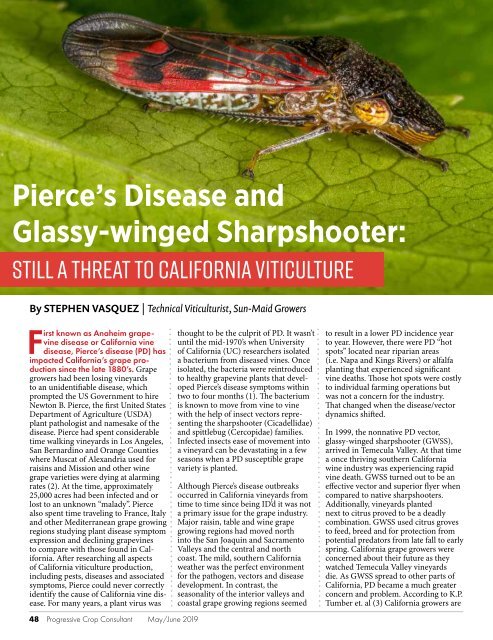PCC_MayJun_2019_e
You also want an ePaper? Increase the reach of your titles
YUMPU automatically turns print PDFs into web optimized ePapers that Google loves.
Pierce’s Disease and<br />
Glassy-winged Sharpshooter:<br />
Still a Threat to California Viticulture<br />
By STEPHEN VASQUEZ | Technical Viticulturist, Sun-Maid Growers<br />
First known as Anaheim grapevine<br />
disease or California vine<br />
disease, Pierce’s disease (PD) has<br />
impacted California’s grape production<br />
since the late 1880’s. Grape<br />
growers had been losing vineyards<br />
to an unidentifiable disease, which<br />
prompted the US Government to hire<br />
Newton B. Pierce, the first United States<br />
Department of Agriculture (USDA)<br />
plant pathologist and namesake of the<br />
disease. Pierce had spent considerable<br />
time walking vineyards in Los Angeles,<br />
San Bernardino and Orange Counties<br />
where Muscat of Alexandria used for<br />
raisins and Mission and other wine<br />
grape varieties were dying at alarming<br />
rates (2). At the time, approximately<br />
25,000 acres had been infected and or<br />
lost to an unknown “malady”. Pierce<br />
also spent time traveling to France, Italy<br />
and other Mediterranean grape growing<br />
regions studying plant disease symptom<br />
expression and declining grapevines<br />
to compare with those found in California.<br />
After researching all aspects<br />
of California viticulture production,<br />
including pests, diseases and associated<br />
symptoms, Pierce could never correctly<br />
identify the cause of California vine disease.<br />
For many years, a plant virus was<br />
thought to be the culprit of PD. It wasn’t<br />
until the mid-1970’s when University<br />
of California (UC) researchers isolated<br />
a bacterium from diseased vines. Once<br />
isolated, the bacteria were reintroduced<br />
to healthy grapevine plants that developed<br />
Pierce’s disease symptoms within<br />
two to four months (1). The bacterium<br />
is known to move from vine to vine<br />
with the help of insect vectors representing<br />
the sharpshooter (Cicadellidae)<br />
and spittlebug (Cercopidae) families.<br />
Infected insects ease of movement into<br />
a vineyard can be devastating in a few<br />
seasons when a PD susceptible grape<br />
variety is planted.<br />
Although Pierce’s disease outbreaks<br />
occurred in California vineyards from<br />
time to time since being ID’d it was not<br />
a primary issue for the grape industry.<br />
Major raisin, table and wine grape<br />
growing regions had moved north<br />
into the San Joaquin and Sacramento<br />
Valleys and the central and north<br />
coast. The mild, southern California<br />
weather was the perfect environment<br />
for the pathogen, vectors and disease<br />
development. In contrast, the<br />
seasonality of the interior valleys and<br />
coastal grape growing regions seemed<br />
to result in a lower PD incidence year<br />
to year. However, there were PD “hot<br />
spots” located near riparian areas<br />
(i.e. Napa and Kings Rivers) or alfalfa<br />
planting that experienced significant<br />
vine deaths. Those hot spots were costly<br />
to individual farming operations but<br />
was not a concern for the industry.<br />
That changed when the disease/vector<br />
dynamics shifted.<br />
In 1999, the nonnative PD vector,<br />
glassy-winged sharpshooter (GWSS),<br />
arrived in Temecula Valley. At that time<br />
a once thriving southern California<br />
wine industry was experiencing rapid<br />
vine death. GWSS turned out to be an<br />
effective vector and superior flyer when<br />
compared to native sharpshooters.<br />
Additionally, vineyards planted<br />
next to citrus proved to be a deadly<br />
combination. GWSS used citrus groves<br />
to feed, breed and for protection from<br />
potential predators from late fall to early<br />
spring. California grape growers were<br />
concerned about their future as they<br />
watched Temecula Valley vineyards<br />
die. As GWSS spread to other parts of<br />
California, PD became a much greater<br />
concern and problem. According to K.P.<br />
Tumber et. al (3) California growers are<br />
48 Progressive Crop Consultant May/June <strong>2019</strong>


















